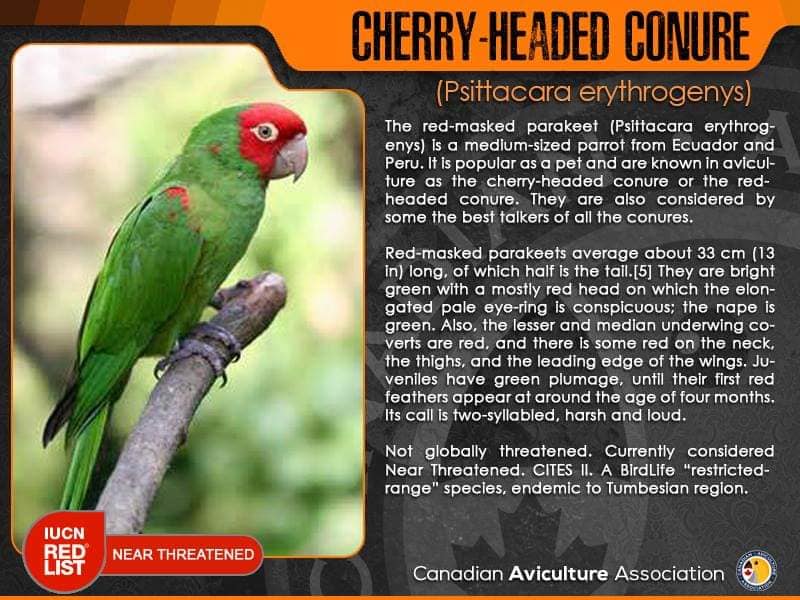Cherry Headed Conure - Psittacara Erythrogenys - Near Threatened
The cherry headed parakeet (Psittacara erythrogenys) is a medium-sized parrot from Ecuador and Peru. It is popular as a pet and are known in aviculture as the cherry-headed conure or the red-headed conure. They are also considered the best talkers of all the conures.
Description: Red-masked parakeets average about 33 cm (13 in) long, of which half is the tail. They are bright green with a mostly red head on which the elongated pale eye-ring is conspicuous; the nape is green. Also, the lesser and median underwing coverts are red, and there is some red on the neck, the thighs, and the leading edge of the wings. Juveniles have green plumage, until their first red feathers appear at around the age of four months. Its call is two-syllabled, harsh and loud.
Habitat and Distribution: These birds are native to southwestern Ecuador and northwestern Peru, where they primarily live in jungle and deciduous forest. They can also thrive in semiarid regions as well as in suburban regions.[6] While they can live up to 2,500 metres (8,200 ft) above sea level, they are usually found below the 1,500 metres (4,900 ft) mark. Their wide distribution and popularity as pets contributes to their successful introduction in other areas upon release especially in the southern areas of the United States as exotic feral birds.
Feral Populations: Escaped cage birds are considered to be introduced in Spain and in El Yunque Rain Forest in Rio Grande, Puerto Rico. They are also found in the United States especially in Florida and California. They make up most of the feral population in San Francisco which is documented in the film The Wild Parrots of Telegraph Hill by Judy Irving, based on the book of the same name by Mark Bittner. They are also seen in part of Hawaii. Although these birds reproduce in the wild, the red-masked parakeet is not considered established in North America. Breeding populations of feral parakeets have been observed in San Diego County, Los Angeles, San Gabriel Valley, Orange County, California, Sunnyvale, Palo Alto, Long Beach, Houston, Texas, and San Francisco. The birds have been observed feeding on the fruits of the cultivated tropical vegetation and nesting in the ubiquitous palm trees. These feral parrots are also introduced in Hermosillo, Sonora, Mexico.
Breeding: Clutches average three to four eggs and incubation is over within 23 or 24 days. Nests are usually made in tree cavities and they can breed successfully in small woodlots or even isolated trees in degraded forests. Juvenile birds fledge after 50 days with green plumage.

Psittaciformes, The Parrot Index, a part of Phoenix Feathers © 2016 - 2023
Page last updated: 12/24/23
Phoenix Feathers

